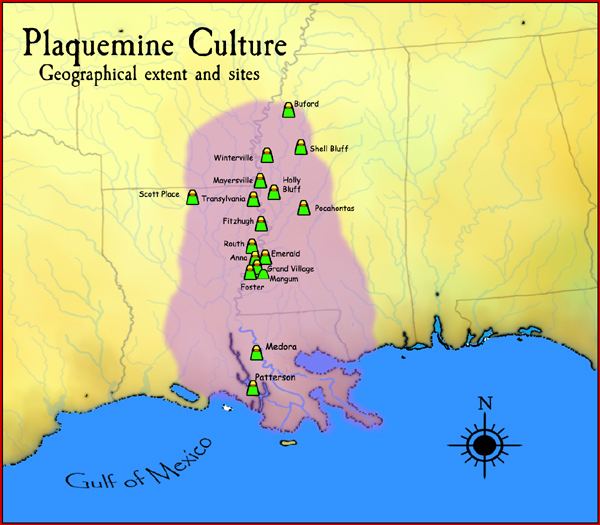 | ||
The Plaquemine culture was an archaeological culture in the lower Mississippi River Valley in western Mississippi and eastern Louisiana. Good examples of this culture are the Medora Site (the type site for the culture and period) in West Baton Rouge Parish, Louisiana, and the Anna, Emerald Mound, Winterville and Holly Bluff sites located in Mississippi. Plaquemine culture was contemporaneous with the Middle Mississippian culture in the Cahokia site in St. Louis, Missouri. It is considered ancestral to the Natchez and Taensa peoples.
Contents
Architecture and mounds
The Plaquemine Culture occupied the rest of Louisiana not taken by the Caddoan Mississippian culture during this time frame. Its people are considered descendants of the Troyville-Coles Creek culture. A prominent feature of Plaquemine sites are large ceremonial centers with two or more large mounds facing an open plaza. The flat-topped, pyramidal mounds were constructed in several stages. Sometimes they were topped by one or two smaller mounds. Mounds were often built on top of the ruins of a house or temple and similar buildings were usually constructed on top of the mound.
In earlier times, buildings were usually circular, but later they were likely to be rectangular. They were constructed of wattle and daub, and sometimes with wall posts sunk into foot-deep wall trenches. At times, shallow, oval or rectangular graves were dug in the mounds. These might have been for primary burials, but more often they were for the reburial of remains originally interred elsewhere.
Pottery
One kind of pottery occasionally placed in the graves is called "killed" pottery. This type has a hole in the base of the vessel that was cut while the pot was being made, usually before it was fired. They also decorated their pots in other characteristic ways. They sometimes added small solid handles called lugs and textured the surface by brushing clumps of grass over the vessel before it was fired. They often cut designs into the surface of the wet clay and, like their Caddoan contemporaries, the Plaquemine peoples engraved designs on pots after they were fired. Plaquemine peoples also had undecorated pots that they used for ordinary daily tasks. Pottery during this phase still used dry clay particles as a tempering material, with the use of ground shell being a marker for Mississippian cultural contact.
Plaquemine Mississippian
Beginning during the Terminal Coles Creek period (1150 to 1250 CE), Mississippian cultures far upstream from the Plaquemine area began expanding their reach southward. Excavations in the Yazoo Basin area of Mississippi have shown a Cahokia Horizon as extra-regional exotic goods, such as Cahokian pottery and other artifacts, began to be deposited in Coles Creek-Plaquemine culture sites. Through repeated contacts, groups in Mississippi and then Louisiana began adopting Mississippian techniques for making Mississippian culture pottery, as well as ceremonial objects and possibly social structuring.
The Plaquemine peoples absorbed more Mississippian influence and the area of their distinct culture began to shrink after 1350 CE. Eventually the last enclave of purely Plaquemine culture was the Natchez Bluffs area, while the Yazoo Basin and Louisiana areas became a hybrid Plaquemine Mississippian culture. Historic groups in the area during first European contact bear out this division. In the Natchez Bluffs, the Taensa and Natchez, had held out against Mississippian influence. They continued to use the same sites as their ancestors and carry on the Plaquemine culture. Groups who appear to have absorbed more Mississippian influence were identified at the time of European contact as those tribes speaking the Tunican, Chitimachan, and Muskogean languages.
